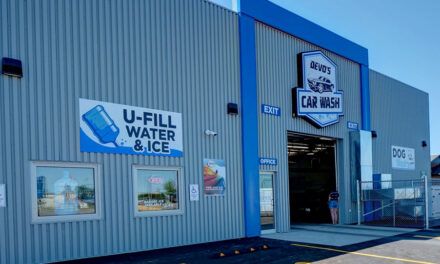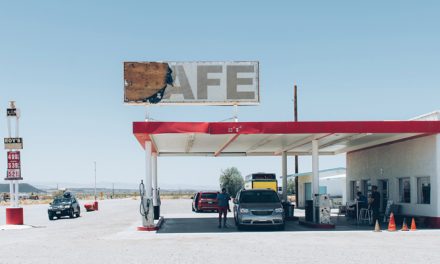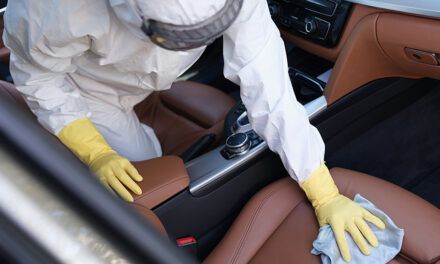
Carwash – What’s New for 2021

Carwash – What’s New for 2021
By Anthony Analetto
From entry systems and subscriptions, to doors and dryers, the carwash industry across North America is a changing landscape as new technology broadens the choices that operators have. The following provides some information to introduce what’s new and what’s coming for 2021.
DRB
By Todd Davy
 Point-of-sale and related technology has taken the carwash industry further than anyone could have imagined. It made unlimited wash plans not only feasible but central to a carwash business and the growth of the entire industry. It provided data that helped operators adjust and optimize their operations. It streamlined nearly every aspect of running a carwash.
Point-of-sale and related technology has taken the carwash industry further than anyone could have imagined. It made unlimited wash plans not only feasible but central to a carwash business and the growth of the entire industry. It provided data that helped operators adjust and optimize their operations. It streamlined nearly every aspect of running a carwash.
Technology is poised to usher in another era of industry growth. The carwash point-of-sale system of the future will be simple to learn, use and configure while delivering unique and meaningful experiences to staff and consumers.
Advanced technology will allow carwash operators to lock in consumer loyalty and squeeze every ounce of profitability out of their businesses.
Future carwash POS systems will be built on a modern hybrid cloud architecture that will facilitate automatic software updates and remote access. While leveraging the power of the cloud, washes will remain up and running even when their internet connection fails or is spotty.

The modern POS system will collect and deliver data in ways that will allow carwash operators to be predictive and make data-driven decisions to grow business. Taking that to the next level, artificial intelligence and machine learning will drive automatic actions that will create revenue growth. Imagine a system that not only automatically sends out a coupon during slow times but also adjusts delivery and messaging based on the customer’s profile and performance of previous offers!
More than ever, the point-of-sale will be a valuable ally as carwash operators face increased competition, increasing regulation and rising consumer expectations.
Todd Davy is senior vice president of sales with DRB.
ISTOBAL
 COVID-19 has made clear the need to reinforce cleaning measures in vehicles in order to increase the safety of drivers and occupants as well as to prevent the spread of the virus. Not only the carwash facilities, but especially businesses related to the automotive world (such as carsharing, rent a car, VTC, transport and logistics companies, repair facilities and auto dealers, among others) are evaluating different sanitization solutions for both the interior and the exterior of vehicles. The pandemic has caused the demand for these new technologies and sanitization products to grow rapidly.
COVID-19 has made clear the need to reinforce cleaning measures in vehicles in order to increase the safety of drivers and occupants as well as to prevent the spread of the virus. Not only the carwash facilities, but especially businesses related to the automotive world (such as carsharing, rent a car, VTC, transport and logistics companies, repair facilities and auto dealers, among others) are evaluating different sanitization solutions for both the interior and the exterior of vehicles. The pandemic has caused the demand for these new technologies and sanitization products to grow rapidly.
According to the WHO (World Health Organization), cleaning is an essential first step in surface disinfection processes since it eliminates pathogens and reduces the viral load. Organic matter can prevent a disinfectant having direct contact with a surface and inactivate the germicidal properties or the mode of action of several disinfectants. For this reason, ISTOBAL recommends thoroughly cleaning both the exterior and interior of the car, as a preliminary step to the correct and effective sanitization of the vehicle.
The main point to consider is that a regular vehicle wash is still the most important and effective. Including a special sanitization program in the wash process manages to reinforce this cleaning and this is what ISTOBAL is recommending to carwash facilities.

Disinfection requires special chemicals that must be used with exact dosages and concentrations and with precise application times for disinfection to be truly effective. These special chemicals must be correctly registered and approved by regulatory authorities and must also be previously tested so that they do not damage any car surfaces, both on the exterior and the interior. For instance, ISTOBAL has tested that hydro-alcoholic products can dry out the dashboard material and affect screens or plastics if the surface temperature is high, so they are not suitable for sanitizing the interior of the car.
To rely on a professional carwash facility that uses suitable equipment and products is the first step you must take in order to wash and sanitize the car with all the guarantees of efficiency and safety.
SUBSCRIPTION OPTIONS
By Paula Thomas
For convenience and carwash retailers, a truly exciting trend is the explosion of subscription options for customers.
The concept of paying a fixed fee each month has been incredibly successful for years for brands like Amazon Prime and Netflix, proving that customers love the simplicity of a fixed monthly charge for services they value.
Research shows that this is even more popular when the economy is challenging, with coffee retailers like Panera Bread in the U.S. enjoying unprecedented success as hundreds of thousands of subscribers now pay them a monthly fee for unlimited coffee.
For carwash retailers, the technology needed to manage a subscription program has become more easily available, allowing you to set prices and manage promotions. Your subscription program can be built either as a stand-alone app or integrated in to your existing app or digital loyalty programme.
Several global brands already boast carwash subscription programs, no doubt excited by the promise of recurring revenue as loyal customers wash their cars more often.
Couche Tard is again the market leader, operating subscription programs in Canada, the U.S. and Europe using the Liquid Barcodes platform, suggesting impressive results with this innovative business model.
Key success factors and advice from leading subscription loyalty experts include:
- Offer a number of subscription options from basic to premium, and allow subscribers the ability to upgrade or downgrade at any time.
- Set up automatic monthly billing and remind customers in advance to build their trust and encourage usage. Remember to thank them regularly too.
Key benefits of subscription for carwash customers:
- Your subscription service can allow customers to buy and activate their carwash from inside their car, something they particularly value when the weather conditions are bad.
- Customers increasingly want contactless solutions given Covid19 concerns, so your subscription solution can easily be positioned as another way your carwash business is helping customers to wash safely and easily.
In an otherwise challenging year, subscribers have proven to be more loyal to brands than other customers. While the model may take some time for mass market adoption, it does measurably improve the lifetime value of your customers.
With subscription programs exploding in popularity, it’s important to note they are not a quick fix, but the model does deliver longer term revenue benefits and returns than the carwash industry has ever enjoyed before.
Paula is an independent loyalty expert who writes and podcasts about loyalty in fuel and convenience retail for Liquid Barcodes. She has published a book entitled “Driving Loyalty in Convenience Retail”.
As well as being the voice of the Liquid Barcodes Live Loyalty Podcast she is also the host of her own show, the first independent podcast for loyalty professionals called Let’s Talk Loyalty.
AIRLIFT DOORS, INC.
By Brian Schmitz
Technology in the carwash door industry has advanced tremendously over the years. Door controls have grown from simple, stand alone, push button controls to advanced systems that directly inter-face with automatic carwash equipment. The vast majority of carwash controllers seamlessly connect to door controls and are not only able to open and close the doors as needed during the wash cycle, but are most are able to control the doors via temperature and can even alert owners when a door is open for an extended period of time. In colder climates especially, these features offer carwash owners reliability and peace of mind that their doors will operate accordingly in freezing temperatures and during the busiest times of the year.
Technology not only allows carwash equipment to control the doors directly, but also provides means of automating door operation if that interface is not available. Accessories such as infrared sensors, motion detectors, in ground loop detectors, and timers are just some of the additional options that can be used to fully automate door operation as a stand alone system. These accessories are specifically designed with the carwash environment in mind and have proven to be very reliable. Additional controls such as these are an important, and valuable addition to some carwash configurations. Not only can they add additional safety, but they can provide for more reliable automatic door operation if the carwash equipment is unable to do so.
Self-serve carwashes aren’t exempt from these additional options. Many self-serve owners have begun utilizing automated controls to provide their customers with a better wash experience and reduce bay heating costs. By implementing some of these features into their self-serve bays, customers no longer are required to manually operate the doors and owners can be assured their doors are closed once the customer leaves.
As you can see, better technology in the carwash door industry has provided carwash owners with products that are reliable and flexible to their needs. Utilizing the technology now available ensures that carwash doors are a valuable component in all washing environments and situations.
Brian Schmitz is operations manager with Airlift Doors, Inc.
AERODRY
By Cheryl Ehmen

The guitar is a musical instrument, so its goal in life is to make musical sound. Music is the arrangement of tones into patterns that the human brain finds pleasing. A carwash dryer is industrial machinery, with the goal of performing a task within a production process. Rarely does the human brain perceive audible signals generated by machinery as pleasing. That is why manufacturers of industrial machinery work hard at keeping down the noise levels emanating from their products. For this same reason, regulators take an interest. Tonal noise, i.e., sound at single tone, can be particularly annoying. Planning authorities have begun targeting specific tones in some carwash markets with the result that equipment can be deemed non-compliant even if the average decibel levels meet requirements.
Noise is directly related to airflow efficiency. The correctly configured fan must be perfectly balanced; fan-tip clearance must be the same all the way around. Variations in tip clearance cause additional noise and also reduce fan efficiency. Great care must be taken to get the geometry as exact as practical.
Prior to planning and preparing, I made a list of non-negotiables – performance, quality, and absence of maintenance. Experience as both an operator and a manufacturer factored into decisions and goals. Baseline noise measurements of the current system were taken and evaluated under the same conditions as those of the improvements. Measurements must be made in an environment that does not have reflecting surfaces within five meters. The background noise level was at least 10 dbA below the measured level of the system in operation. In a carwash dryer, there are three major points of testing: the air intake, the air producer, and the air outlet. Calibrated audio recordings were required for each noise and performance point. Data was gathered, analyzed, and assessed for each point, then modifications develop
for that point to reduce it below the subsequent points. We then continued to the next highest noise point, with likewise intent and practice, continuing in sequence.
Modeling of airflow through the fan allows the flow needed to be visualized. This would be the first step in obtaining initial recommendations to modify a fan system with reduced noise and improved efficiency.
This would be the first step in obtaining initial recommendations to modify a fan system with reduced noise and improved efficiency. Noise is directly related to airflow efficiency. The correctly configured fan must be perfectly balanced; fan-tip clearance must be the same all the way around. Variations in tip clearance cause additional noise and also reduce fan efficiency. Great care must be taken to get the geometry as exact as practical.
Even a 5 dB change is more than a 50 per cent change in acoustic energy. dbA levels are “A” weighted according to the weighting curves to approximate the way the human ear hears. For example, a 100 dB level at 100 Hz will be perceived to have a loudness equal to only 80 dB at 1,000 Hz. The dbA scale is based on a child’s hearing and was originally documented based on actual hearing tests to characterize the human ear’s relative response to noise.
The challenge had been to provide compliance solutions for newly enforced tonal requirements in certain markets. Success. After four round of testing by international and domestic consultants, we were able reduce sound emissions by up to 15 dbA. The modifications included altering design of the intake, silencers, and changing the acoustic material while keeping the costs of the overall noise package to the minimum practical.
Cheryl Ehmen owns Aerodry Systems LLC based in Denver, CO. She formerly owned carwashes in Texas in the 1980s and also the manufacturer, Worldwide Drying Systems in the 1990s. For more information on this article or Aerodry, e-mail cheryl@aerodrysystems.com


































